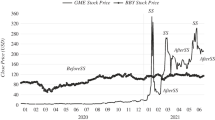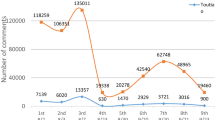Abstract
The risk of peer to peer lending (P2P) platform is predicted based on text data on the Internet to avoid the risk of social network financing and improve the security of social network financing. First, the transaction and review text information of a third-party P2P platform are classified for the time series of emotional changes. Second, the Granger causal relation test is used to verify the correlation between the time series of emotional changes and trading volume. Finally, a long short-term memory (LSTM) forecasting model is proposed based on investors’ emotional changes to predict the trading volume of P2P platforms using emotional changes as a reference for social network financing to avoid risks. The results show that the value of Pearson correlation coefficient between the trading volume of P2P platforms and negative emotions is -0.2088, with a P value less than 1%, indicating a correlation between emotional changes and trading volume. The Pearson correlation coefficient between the predicted and actual values is 0.7995, whereas the mean square error is 0.2190 with a fitting degree of 0.6532. This shows that the LSTM forecasting model can accurately predict the trading volume of P2P platforms with good performance in comparison with other forecasting models.








Similar content being viewed by others
Data availability
The simulation experiment data used to support the findings of this study are available from the corresponding author upon request.
References
Adams P, Burd P (2019) Classic soccer shoes: from an informal to a formal business start-up. Int J Entrepreneurship Innov 20(3):220–226
Bian W, Yan G (2022) Analyzing intention to Purchase Brand Extension via Brand Attribute associations Mediating and moderating role of emotional consumer-brand relationship and brand commitment. Front Psychol 13:4163
Cao H (2022) Entrepreneurship education-infiltrated computer-aided instruction system for college music majors using convolutional neural network. Front Psychol 13:900195
De Stefanis P (2020) Making projects and business in green chemistry: creating a winning start-up, fund raising, and writing competitive research proposals. Stud Surf Sci Catal 179:511–524
Gao H, Hsu P, Li K, Zhang J (2020) The real effect of smoking bans: evidence from Corporate Innovation. J Financial Quant Anal 55(2):387–427
Gao H, Shi D, Zhao B (2021) Does good luck make people overconfident? Evidence from a natural experiment in the stock market. J Corp Finance 68:101933
Gu J, Vo ND, Jung JJ (2022) Contextual Word2Vec model for understanding Chinese out of vocabularies on Online Social Media. Int J Semantic Web Inform Syst 18(1):1–14
Gupta S, Gupta BB, Chaudhary P (2018) Hunting for DOM-Based XSS vulnerabilities in mobile cloud-based online social network. Future Generation Comput Syst 79:319–336
He Q, Zhang X, Xia P, Zhao C, Li S (2023) A Comparison Research on dynamic characteristics of Chinese and American Energy prices. J Global Inform Manage 31(1):1–16
Hirsh JB, Guindon A, Morisano D, Peterson JB (2010) Positive mood effects on delay discounting. Emotion 10(5):717–721
Hu F, Qiu L, Xi X, Zhou H, Hu T, Su N, Wei S (2022) Has COVID-19 changed China’s Digital Trade?—Implications for Health Economics. Front Public Health 10:831549
Li X, Sun Y (2020) Stock intelligent investment strategy based on support vector machine parameter optimization algorithm. Neural Comput Appl 32(6):1765–1775
Li X, Sun Y (2021) Application of RBF neural network optimal segmentation algorithm in credit rating. Neural Comput Appl 33(14):8227–8235
Li T, Li Y, Hoque MA, Xia T, Tarkoma S, Hui P (2020) To what extent we repeat ourselves? Discovering daily activity patterns across mobile app usage. IEEE Trans Mob Comput 21(4):1492–1507
Li L, Wu X, Kong M, Liu J, Zhang J (2023) Quantitatively interpreting residents happiness prediction by considering factor–factor interactions. IEEE Trans Comput Social Syst. https://doi.org/10.1109/TCSS.2023.3246181
Liu Y, Wang K, Liu L, Lan H, Lin L (2022) Tcgl: temporal contrastive graph for self-supervised video representation learning. IEEE Trans Image Process 31:1978–1993
Liu X, He J, Liu M, Yin Z, Yin L, Zheng W (2023a) A scenario-generic neural machine Translation Data Augmentation Method. Electronics 12(10):2320
Liu X, Shi T, Zhou G, Liu M, Yin Z, Yin L, Zheng W (2023b) Emotion classification for short texts: an improved multi-label method. Humanit Social Sci Commun 10(1):306
Lu S, Liu M, Yin L, Yin Z, Liu X, Zheng W, Kong X (2023) The multi-modal fusion in visual question answering: a review of attention mechanisms. PeerJ Comput Sci, 9, e1400
Ni Q, Guo J, Wu W, Wang H (2022a) Influence-based community partition with sandwich method for social networks. IEEE Trans Comput Social Syst 10(2):819–830
Ni Q, Guo J, Wu W, Wang H, Wu J (2022b) Continuous influence-based community partition for Social Networks. IEEE Trans Netw Sci Eng 9(3):1187–1197
Peng Y, Zhao Y, Hu J (2023) On the role of Community structure in evolution of opinion formation: a New Bounded confidence Opinion Dynamics. Inf Sci 621:672–690
Qian L, Zheng Y, Li L, Ma Y, Zhou C, Zhang D (2022) A New Method of Inland Water Ship Trajectory Prediction based on long short-term Memory Network optimized by genetic algorithm. Appl Sci 12(8):4073
Qiu L, Yu R, Hu F, Zhou H, Hu H (2023) How can China’s medical manufacturing listed firms improve their technological innovation efficiency? An analysis based on a three-stage DEA model and corporate governance configurations. Technol Forecast Soc Chang 194:122684
Rahaman MA, Luna KF, Ping ZL, Islam MS, Karim MM (2021) Do Risk-Taking, innovativeness, and Proactivity Affect Business performance of SMEs? A case study in Bangladesh. J Asian Finance Econ Bus 8(5):689–695
Ren Y, Jiang H, Ji N, Yu H (2022) TBSM: a traffic burst-sensitive model for short-term prediction under special events. Knowl Based Syst 240:108120
Sahoo SR, Gupta BB (2018) Security issues and challenges in online social networks (OSNs) based on user perspective. Comput Cyber Secur, 591–606
Sahoo SR, Gupta BB (2021) Multiple features based approach for automatic fake news detection on social networks using deep learning. Appl Soft Comput 100:106983
So KKF, Xie KL, Wu J (2019) Peer-to-peer accommodation services in the sharing economy: effects of psychological distances on guest loyalty. Int J Contemp Hospitality Manage 31(8):3212–3230
Soukalová K, Šubrt J, Štemberk J (2020) A dangerous Mood: Public Opinion and Mass Communication in the Czech lands of 18th century. Historická Sociologie 13(2):9–28
Tembhurne JV, Almin MM, Diwan T (2022) Mc-DNN: fake news detection using multi-channel deep neural networks. Int J Semantic Web Inform Syst (IJSWIS) 18(1):1–20
Tong D, Sun Y, Tang J, Luo Z, Lu J, Liu X (2023) Modeling the interaction of internal and external systems of rural settlements: the case of Guangdong, China. Land Use Policy 132:106830
Wang H, Cui Z, Liu R, Fang L, Sha Y (2023) A multi-type transferable method for Missing Link Prediction in Heterogeneous Social Networks. IEEE Trans Knowl Data Eng. https://doi.org/10.1109/TKDE.2022.3233481
Wu YJ, Liu WJ, Yuan CH (2020) A mobile-based barrier-free service transportation platform for people with disabilities. Comput Hum Behav 107:105776
Wu B, Gu Q, Liu Z, Liu J (2023) Clustered institutional investors, shared ESG preferences and low-carbon innovation in family firm. Technol Forecast Soc Chang 194:122676
Xie X, Jin X, Wei G, Chang C (2023) Monitoring and early warning of SMEs’ Shutdown Risk under the impact of global pandemic shock. Systems 11(5):260
Yang S, Li Q, Li W, Li X, Liu A (2022) Dual-level representation enhancement on characteristic and context for image-text Retrieval. IEEE Trans Circuits Syst Video Technol 32(11):8037–8050
Yi H, Meng X, Linghu Y, Zhang Z (2023) Can financial capability improve entrepreneurial performance? Evidence from rural China. Economic Research-Ekonomska Istraživanja 36(1):1631–1650
Yue Z, Ding S, Zhao W, Wang H, Ma J, Zhang Y, Zhang Y (2019) Automatic CIN grades prediction of sequential cervigram image using LSTM with multistate CNN features. IEEE J Biomedical Health Inf 24(3):844–854
Zenggang X, Mingyang Z, Xuemin Z, Sanyuan Z, Fang X, Xiaochao Z, Xiang L (2022) Social similarity routing algorithm based on socially aware networks in the big data environment. J Signal Process Syst 94(11):1253–1267
Zhang J, Li X, Wu B, Zhou L, Chen X (2023a) Order matters: effect of use versus outreach order disclosure on persuasiveness of sponsored posts. J Res Interact Mark. https://doi.org/10.1108/JRIM-06-2022-0189
Zhang Z, Hao L, Linghu Y, Yi H (2023b) Research on the energy poverty reduction effects of green finance in the context of economic policy uncertainty. J Clean Prod 410:137287
Zhen X, Cai GG, Song R, Jang S (2019) The effects of herding and word of mouth in a two-period advertising signaling model. Eur J Oper Res 275(1):361–373
Zhou F, Wu YJ (2018) How humble leadership fosters employee innovation behavior: a two-way perspective on the leader-employee interaction. Leadersh Organ Dev J 39(3):375–387
Zhou L, Jin F, Wu B, Chen Z, Wang CL (2023) Do fake followers mitigate influencers’ perceived influencing power on social media platforms? The mere number effect and boundary conditions. J Bus Res 158:113589
Acknowledgements
The work is supported by Research Fund of ‘the Belt and Road’ National Audit Institute of Nanjing Audit University and Natural Science Foundation of the Higher Education Institutions of Jiangsu Province of China (Grant No. 22KJB630009).
Author information
Authors and Affiliations
Corresponding authors
Additional information
Publisher’s Note
Springer Nature remains neutral with regard to jurisdictional claims in published maps and institutional affiliations.
Electronic supplementary material
Below is the link to the electronic supplementary material.
Conflict of interest
The authors declare that there’s no conflict of interest.
Rights and permissions
Springer Nature or its licensor (e.g. a society or other partner) holds exclusive rights to this article under a publishing agreement with the author(s) or other rightsholder(s); author self-archiving of the accepted manuscript version of this article is solely governed by the terms of such publishing agreement and applicable law.
About this article
Cite this article
Zhao, Y., Yu, H., Han, C. et al. Analysis of the impact of social network financing based on deep learning and long short-term memory. Inf Syst E-Bus Manage (2024). https://doi.org/10.1007/s10257-023-00665-9
Received:
Revised:
Accepted:
Published:
DOI: https://doi.org/10.1007/s10257-023-00665-9




